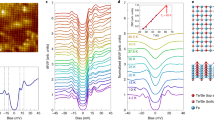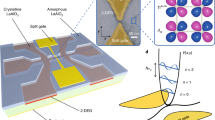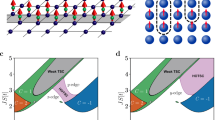Abstract
Exceptional points (EPs) are singularities in non-Hermitian systems, where k (k ≥ 2) eigenvalues and eigenstates coalesce. High-order EPs exhibit richer topological characteristics and better sensing performance than second-order EPs. Theory predicts even richer non-Hermitian topological phases for high-order EP geometries, such as lines or rings formed entirely by high-order EPs. However, experimental exploration of high-order EP geometries has hitherto proved difficult due to the demand for more degrees of freedom in the Hamiltonian’s parameter space or a higher level of symmetries. Here we observe a third-order exceptional line in an atomic-scale system. To this end, we use a nitrogen-vacancy spin in diamond and introduce multiple symmetries in the non-Hermitian Hamiltonian realized with the system. Furthermore, we show that the symmetries play an essential role in the occurrence of high-order EP geometries. Our approach can in future be further applied to explore high-order EP-related topological physics at the atomic scale and, potentially, for applications of high-order EPs in quantum technologies.
This is a preview of subscription content, access via your institution
Access options
Access Nature and 54 other Nature Portfolio journals
Get Nature+, our best-value online-access subscription
$29.99 / 30 days
cancel any time
Subscribe to this journal
Receive 12 print issues and online access
$259.00 per year
only $21.58 per issue
Buy this article
- Purchase on Springer Link
- Instant access to full article PDF
Prices may be subject to local taxes which are calculated during checkout




Similar content being viewed by others
Data availability
The data supporting the findings of this study are available within this article and its Supplementary Information. Source data are provided with this paper.
Code availability
The codes that were used in this study are available from the corresponding author upon reasonable request.
References
Bergholtz, E. J., Budich, J. C. & Kunst, F. K. Exceptional topology of non-Hermitian systems. Rev. Mod. Phys. 93, 015005 (2021).
Yao, S. & Wang, Z. Edge states and topological invariants of non-Hermitian systems. Phys. Rev. Lett. 121, 086803 (2018).
Kawabata, K., Shiozaki, K., Ueda, M. & Sato, M. Symmetry and topology in non-Hermitian physics. Phys. Rev. X 9, 041015 (2019).
Gong, Z. et al. Topological phases of non-Hermitian systems. Phys. Rev. X 8, 031079 (2018).
Lee, T. E. Anomalous edge state in a non-Hermitian lattice. Phys. Rev. Lett. 116, 133903 (2016).
Zhou, H. et al. Observation of bulk Fermi arc and polarization half charge from paired exceptional points. Science 359, 1009–1012 (2018).
Carlström, J. & Bergholtz, E. J. Exceptional links and twisted Fermi ribbons in non-Hermitian systems. Phys. Rev. A 98, 042114 (2018).
Xiao, L. et al. Observation of topological edge states in parity-time-symmetric quantum walks. Nat. Phys. 13, 1117–1123 (2017).
Xiao, L. et al. Non-Hermitian bulk-boundary correspondence in quantum dynamics. Nat. Phys. 16, 761–766 (2020).
Minganti, F., Miranowicz, A., Chhajlany, R. W. & Nori, F. Quantum exceptional points of non-Hermitian Hamiltonians and Liouvillians: the effects of quantum jumps. Phys. Rev. A 100, 062131 (2019).
Minganti, F., Miranowicz, A., Chhajlany, R. W., Arkhipov, I. I. & Nori, F. Hybrid-Liouvillian formalism connecting exceptional points of non-Hermitian Hamiltonians and Liouvillians via postselection of quantum trajectories. Phys. Rev. A 101, 062112 (2020).
Lee, T. E., Reiter, F. & Moiseyev, N. Entanglement and spin squeezing in non-Hermitian phase transitions. Phys. Rev. Lett. 113, 250401 (2014).
Hassan, A. U., Zhen, B., Soljačić, M., Khajavikhan, M. & Christodoulides, D. N. Dynamically encircling exceptional points: exact evolution and polarization state conversion. Phys. Rev. Lett. 118, 093002 (2017).
Stalhammar, M. & Bergholtz, E. J. Classification of exceptional nodal topologies protected by PT symmetry. Phys. Rev. B 104, L201104 (2021).
Chang, L. et al. Parity–time symmetry and variable optical isolation in active-passive-coupled microresonators. Nat. Photon. 8, 524 (2014).
Peng, B. et al. Parity-time symmetric whispering-gallery microcavities. Nat. Phys. 10, 394 (2014).
Lin, Z. et al. Unidirectional invisibility induced by PT-symmetric periodic structures. Phys. Rev. Lett. 106, 213901 (2011).
Feng, L., Wong, Z. J., Ma, R.-M., Wang, Y. & Zhang, X. Single mode laser by parity–time symmetry breaking. Science 346, 972 (2014).
Hodaei, H., Miri, M.-A., Heinrich, M., Christodoulides, D. N. & Khajavikhan, M. Parity–time-symmetric microring lasers. Science 346, 975 (2014).
Chen, W., Özdemir, S. K., Zhao, G., Wiersig, J. & Yang, L. Exceptional points enhance sensing in an optical microcavity. Nature 548, 192 (2017).
Hokmabadi, M. P., Schumer, A., Christodoulides, D. N. & Khajavikhan, M. Non-Hermitian ring laser gyroscopes with enhanced Sagnac sensitivity. Nature 576, 70 (2019).
Fernández-Alcázar, L. J., Kononchuk, R. & Kottos, T. Enhanced energy harvesting near exceptional points in systems with (pseudo-) PT-symmetry. Commun. Phys. 4, 79 (2021).
Hu, H. & Zhao, E. Knots and non-Hermitian Bloch bands. Phys. Rev. Lett. 126, 010401 (2021).
Zhang, W. et al. Observation of non-Hermitian topology with nonunitary dynamics of solid-state spins. Phys. Rev. Lett. 127, 090501 (2021).
Abbasi, M., Chen, W., Naghiloo, M., Joglekar, Y. N. & Murch, K. W. Topological quantum state control through exceptional-point proximity. Phys. Rev. Lett. 128, 160401 (2022).
Liu, W., Wu, Y., Duan, C.-K., Rong, X. & Du, J. Dynamically encircling an exceptional point in a real quantum system. Phys. Rev. Lett. 126, 170506 (2021).
Wu, Y. et al. Observation of parity-time symmetry breaking in a single-spin system. Science 346, 878–880 (2019).
Ding, L. et al. Experimental determination of PT-symmetric exceptional points in a single trapped ion. Phys. Rev. Lett. 126, 083604 (2021).
Ding, K., Ma, G., Xiao, M., Zhang, Z. Q. & Chan, C. T. Emergence, coalescence, and topological properties of multiple exceptional points and their experimental realization. Phys. Rev. X 6, 021007 (2016).
Delplace, P., Yoshida, T. & Hatsugai, Y. Symmetry-protected higher-order exceptional points and their topological characterization. Phys. Rev. Lett. 127, 186602 (2021).
Mandal, I. & Bergholtz, E. J. Symmetry and higher-order exceptional points. Phys. Rev. Lett. 127, 186601 (2021).
Hodaei, H. et al. Enhanced sensitivity at higher-order exceptional points. Nature 548, 187 (2017).
Zeng, C. et al. Ultra-sensitive passive wireless sensor exploiting high-order exceptional point for weakly coupling detection. New J. Phys. 23, 063008 (2021).
Wang, X. G., Guo, G. H. & Berakdar, J. Enhanced sensitivity at magnetic high-order exceptional points and topological energy transfer in magnonic planar waveguides. Phys. Rev. Appl. 15, 034050 (2021).
Zeng, C. et al. Enhanced sensitivity at high-order exceptional points in a passive wireless sensing system. Opt. Express 27, 27562 (2019).
Patil, Y. S. S. et al. Measuring the knot of non-Hermitian degeneracies and non-commuting braids. Nature 607, 271–275 (2022).
Tang, W. et al. Exceptional nexus with a hybrid topological invariant. Science 370, 1077 (2020).
Ding, K., Fang, C. & Ma, G. Non-Hermitian topology and exceptional-point geometries. Nat. Rev. Phys. 4, 745–760 (2022).
Yang, Z., Schnyder, A. P., Hu, J. & Chiu, C.-K. Fermion doubling theorems in two-dimensional non-Hermitian systems for Fermi points and exceptional points. Phys. Rev. Lett. 126, 086401 (2021).
Yu, Y. et al. Experimental unsupervised learning of non-Hermitian knotted phases with solid-state spins. NPJ Quantum Inf. 8, 116 (2022).
Zhong, Q. et al. Sensing with exceptional surfaces in order to combine sensitivity with robustness. Phys. Rev. Lett. 122, 153902 (2019).
Qin, G.-Q. et al. Experimental realization of sensitivity enhancement and suppression with exceptional surfaces. Laser Photonics Rev. 15, 2000569 (2021).
Soleymani, S. et al. Chiral and degenerate perfect absorption on exceptional surfaces. Nat. Commun. 13, 599 (2022).
Tang, W., Ding, K. & Ma, G. Direct measurement of topological properties of an exceptional parabola. Phys. Rev. Lett. 127, 034301 (2021).
Ding, K., Ma, G., Zhang, Z. Q. & Chan, C. T. Experimental demonstration of an anisotropic exceptional point. Phys. Rev. Lett. 121, 085702 (2018).
Lau, H.-K. & Clerk, A. A. Fundamental limits and non-reciprocal approaches in non-Hermitian quantum sensing. Nat. Commun. 9, 4320 (2018).
Wiersig, J. Review of exceptional point-based sensors. Photon. Res. 8, 1457–1467 (2020).
Yu, S. et al. Experimental investigation of quantum PT-enhanced sensor. Phys. Rev. Lett. 125, 240506 (2020).
Yao, S., Yan, Z. & Wang, Z. Topological invariants of Floquet systems: general formulation, special properties, and Floquet topological defects. Phys. Rev. B 96, 195303 (2017).
Teo, J. C. Y. & Kane, C. L. Topological defects and gapless modes in insulators and superconductors. Phys. Rev. B 82, 115120 (2010).
Tang, W., Ding, K. & Ma, G. Realization and topological properties of third-order exceptional lines embedded in exceptional surfaces. Nat. Commun. 14, 6660 (2023).
Acknowledgements
This work was supported by the National Key R&D Program of China (grant number 2018YFA0306600 (J.D.)), the National Natural Science Foundation of China (grant numbers 12174373 (Yang Wu), 92265204 (Ya Wang) and 12261160569 (X.R.)). J.D. acknowledges funding from the Chinese Academy of Sciences (grant numbers XDC07000000 and GJJSTD20200001), the Innovation Program for Quantum Science and Technology (grant number 2021ZD0302200), the Anhui Initiative in Quantum Information Technologies (grant number AHY050000) and the Hefei Comprehensive National Science Center. Ya Wang thanks the Fundamental Research Funds for the Central Universities for their support. W.L. is funded by Beijing University of Posts and Telecommunications Innovation Group. This work was partially carried out at the USTC Center for Micro and Nanoscale Research and Fabrication.
Author information
Authors and Affiliations
Contributions
J.D. and X.R. proposed the idea and supervised the experiments. X.R., Yang Wu and Yunhan Wang designed the experiments. Yunhan Wang and Yang Wu performed the experiments. X.Y. and Ya Wang prepared the sample. Yunhan Wang, Yang Wu, W.L., Z.N. and C.-K.D. carried out the calculations. All authors analysed the data, discussed the results and wrote the manuscript.
Corresponding authors
Ethics declarations
Competing interests
The authors declare no competing interests.
Peer review
Peer review information
Nature Nanotechnology thanks Weijian Chen and the other, anonymous, reviewers for their contribution to the peer review of this work.
Additional information
Publisher’s note Springer Nature remains neutral with regard to jurisdictional claims in published maps and institutional affiliations.
Extended data
Extended Data Fig. 1 Measurement of the parameters \({\mathbf{\gamma }}_{\mathbf{exp }}\), \({\mathbf{h}}_{\mathbf{exp }}\), \({\mathbf{\mu }}_{\mathbf{exp }}\) and \({\mathbf{\nu }}_{\mathbf{exp }}\) of the non-Hermitian Hamiltonian.
a, The measured quantities CPT and the retrieved parameter \({\nu }_{\exp }\). b, The measured quantities CpsCh and the retrieved parameter \({\mu }_{\exp }\). c-d, Population evolution under Hμ,ν(γ,h) with two different sets of initial states and measurement bases. \({\mu }_{\exp }\) and \({\nu }_{\exp }\) are obtained via linear fitting, and \({\gamma }_{\exp }\) and \({{{{\rm{h}}}}}_{\exp }\) are obtained from the evolution as described in the text. Red dots with error bars are experimental results, and blue lines are the theoretical predictions. All errors shown are one standard deviation with one million averages.
Extended Data Fig. 2 Eigenstates of the non-Hermitian Hamiltonian at the EP3 where μ=ν=0, h=0, γ=1.
a-f, Real (a,c,e) and imaginary (b,d,f) parts of the measured density matrices \({{\rho }_{1}}^{\exp }\) (a,b), \({{\rho }_{2}}^{\exp }\) (c,d) and \({{\rho }_{3}}^{\exp }\) (e,f) of three eigenstates (labelled by 1,2 and 3) obtained by quantum state tomography. g,h,\({{\rho }_{1}}^{{{{\rm{theo}}}}}\)=\({{\rho }_{2}}^{{{{\rm{theo}}}}}\)=\({{\rho }_{3}}^{{{{\rm{theo}}}}}\)=ρtheo is the real (g) and imaginary (h) parts the density matrix of theoretically predicted eigenstate. All errors shown are one standard deviation with one million averages.
Supplementary information
Supplementary Information
Supplementary discussion including Supplementary Figs. 1–9 and Table 1.
Supplementary Data 3
The result of the Ramsey experiment and the Rabi oscillation driven by the AC electric fields.
Supplementary Data 5
The measured quantities CpsCh and CPT and the retrieved parameters \({\mu }_{\exp }\) and \({\nu }_{\exp }\).
Supplementary Data 6
Population evolution under Hμ,ν(γ,h) with two different sets of initial states and measurement bases.
Supplementary Data 7
Eigenstates of the NH Hamiltonian at the EP3 where μ=ν=0, h=0.35 and γ=1.06.
Supplementary Data 8
Eigenstates of the NH Hamiltonian at the EP2 where μ=0.2, ν=0, h=-0.35 and γ=0.73.
Supplementary Data 9
Eigenstates of the NH Hamiltonian with μ=0.2, ν=0.05, h=0 and γ=0.96.
Source data
Source Data Fig. 3
Source Data for Fig. 3
Source Data Fig. 4
Source Data for Fig. 4
Source Data Extended Data Fig./Table 1
Source Data for Extended Data Fig. 1.
Source Data Extended Data Fig./Table 2
Source Data for Extended Data Fig. 1.
Rights and permissions
Springer Nature or its licensor (e.g. a society or other partner) holds exclusive rights to this article under a publishing agreement with the author(s) or other rightsholder(s); author self-archiving of the accepted manuscript version of this article is solely governed by the terms of such publishing agreement and applicable law.
About this article
Cite this article
Wu, Y., Wang, Y., Ye, X. et al. Third-order exceptional line in a nitrogen-vacancy spin system. Nat. Nanotechnol. 19, 160–165 (2024). https://doi.org/10.1038/s41565-023-01583-0
Received:
Accepted:
Published:
Issue Date:
DOI: https://doi.org/10.1038/s41565-023-01583-0



